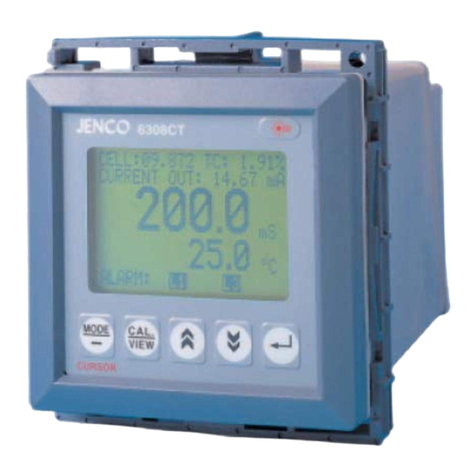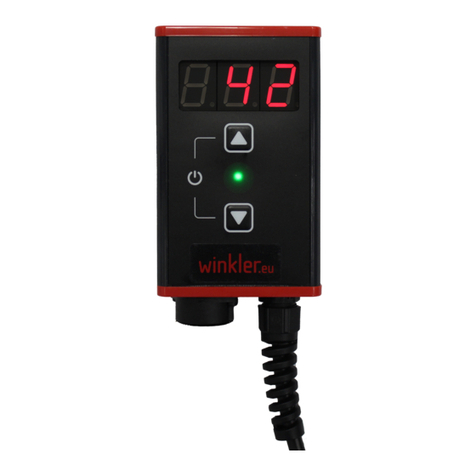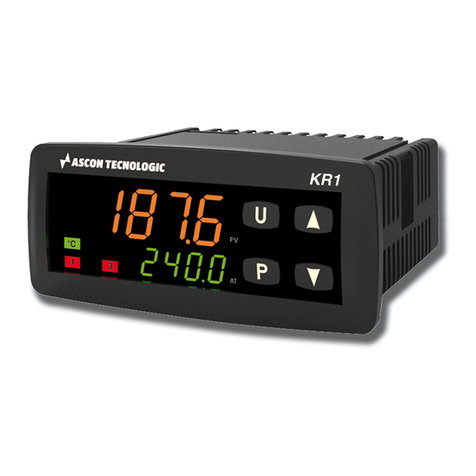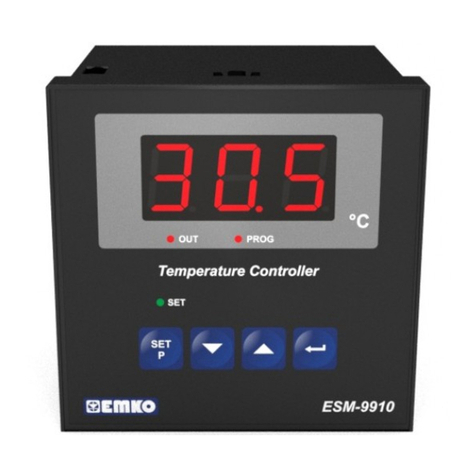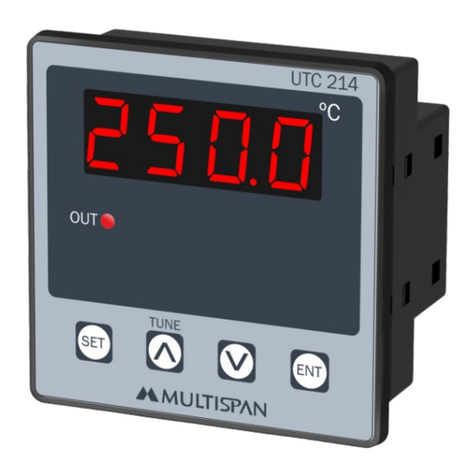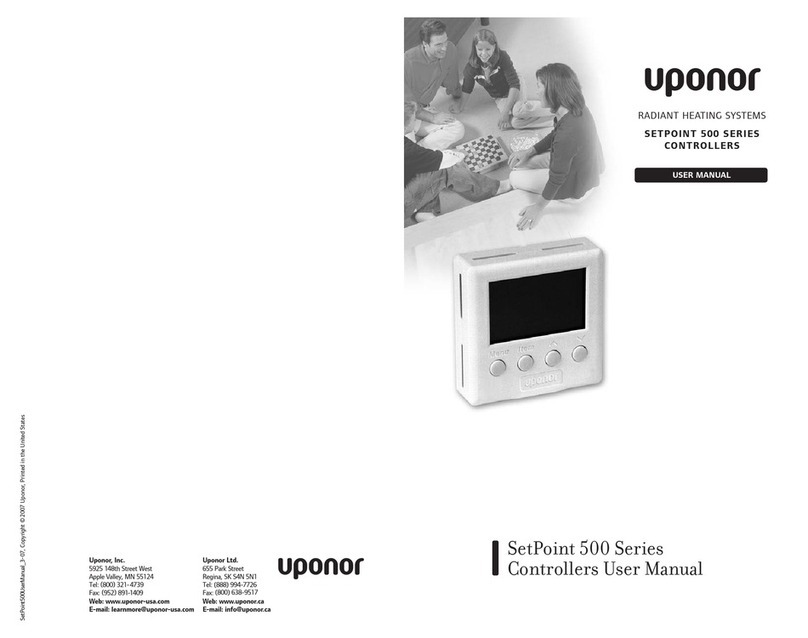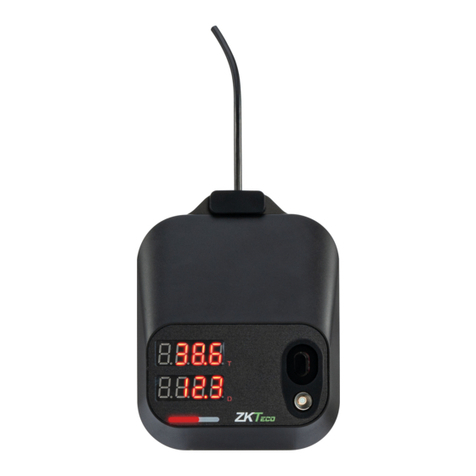JENCO 6311 User manual

OPERATION MANUAL
JENCO MODEL 6311
MICROCOMPUTER BASED
pH / ORP and Temperature
CONTROLLER
JENCO INSTRUMENTS, INC. JENCO ELECTRONICS, LTD.
7968 ARJONS DR., SUITE C P.O. BOX LINKOU-117
SAN DIEGO, CA 92126 TAIPEI HSIEN, TAIWAN,R.O.C.
TEL: (858) 578-2828 TEL: (886-2) 2601-6191
FAX: (858) 578-2886 FAX: (886-2) 2601-7206
SHANGHAI JENCO ELECTRONICS, LTD.
SHANGHAI SONGJIANG SIJING TOWN
EAST ECONOMIC & TECHNOLOGY DEV. AREA (B)
SHANGHAI, CHINA
TEL: 86-21-5761-9599
FAX: 86-21-5761-9598
E-MAIL:[email protected]

2
CONTENTS Page
I. INITIAL INSPECTION and ASSEMBLY 3
II. GENERAL INTRODUCTION 4
III.USING THE JENCO MODEL 6311 5
A.FRONT PANEL 7
B.LCD SCREEN 9
C.REAR CONNECTORS 10
D.TURNING ON/OFF THE INSTRUMENT 10
IV. MODEL 6311 MODES 11
A.MAIN DISPLAY MODE 11
B.CALIBRATION/SETTING MODE 12
a. PASSWORD CHECK screen. 12
b. CALIBRATION/ SETTING SELECT screen 13
1. ACTIVE “pH” 13
i. TEMPERATURE PROBE SELECT 13
ii. pH BUFFER I (STAND) SELECT 14
iii. pH BUFFER II SELECT / iv. STAND CALIBRATION 14
v. SLOPE CALIBRATION / vi. EFFICIENCY information 15
Step by Step pH calibration 15
vii. 4mA SETTING / viii. 20mA SETTING 17
ix. RELAY-1, RELAY-2, RELAY-3, RELAY-4 SETTING
17
x. RELAY 5 (WASH) ON TIME SETTING 18
xi. ID (RS485 ADDRESS) SETTING / xii. PASSWORD SETTING 18
2. ACTIVE “ABS mV” 19
i. TEMPERATURE PROBE SELECT / ii. 4mA SETTING 19
iii. 20mA SETTING / iv.RELAY-1,RELAY-2,RELAY-3,RELAY-4 SETTING 20
v. RELAY 5 (WASH) ON TIME SETTING / vi. ID SETTING 20
vii. PASSWORD SETTING 21
3. ACTIVE “REL mV” 21
i. TEMPERATURE PROBE SELECT 21
ii. OFFSET SETTING / iii. 4mA SETTING 22
iv. 20mA SETTING / v RELAY-1, RELAY-2, RELAY-3, RELAY-4 SETTING 22
vi. RELAY 5 (WASH) ON TIME SETTING / vii. ID SETTING 23
viii. PASSWORD SETTING 23
V. CONTROLLING THE RELAYS 24
A.ISOLATION VOLTAGE 24
B.OUTPUT LOAD 24
C.RELAY ACTION, RELAY SETPOINT & HYSTERESIS VALUE 24
VI. 4-20 mA OUTPUT 25
A.ISOLATION VOLTAGE 25
B.OUTPUT LOAD 25
C.LINEAR ANALOG OUTPUT 25
VII.RS485 INTERFACE OPERATION 27
VIII.ERROR DISPLAYS AND TROUBLESHOOTING 28
IX. pH BUFFERS 30
X. SPECIFICATIONS 31
XI. WARRANTY 32
XII.KEYBOARD FLOWCHARTS 33
A.pH MODE 33
B.“ABS mV” MODE 34
C.“REL mV” MODE 35

3
I. INITIAL INSPECTION and ASSEMBLY
Carefully unpack the instrument and accessories. Inspect for
damages made in shipment. If any damage is found, notify your
Jenco representative immediately. All packing materials should be
saved until satisfactory operation is confirmed.
MOUNTING PROCEDURE
1. Make a cutout on
any panel, with a
thickness of 1/16 in.
(1.5 mm) to 3/8 in.
(9.5mm).
2. Remove the
mounting assembly
from the controller
and insert the
controller into the
cutout.
3. Replace the
mounting bracket
assembly onto the
controller and
secure the controller to the mounting panel.
Warning:
If the equipment is used in a manner not specified by the manufacturer, the
protection provided by the equipment may be impaired.
Cleaning the instrument:
1.Be sure to remove the power before attempting to clean the meter.
2.Use a lint free cloth and clean water or neutral detergent.
3.Wipe the outer surface of the instrument only.

4
4.Wipe-dry the instrument before powering again.
II. GENERAL INTRODUCTION
The Jenco Model 6311 (pH/ORP and Temperature) controller is a
rugged microprocessor based instrument assembled in a watertight
¼DIN case, designed for use in laboratories and process control
applications.
The system simultaneously displays pH or ORP, Temperature and
relay status in one large LCD screen.
The model 6311 microprocessor performs a self-diagnostic routine
every time you turn on the unit providing you with basic
information on the stability of the instrument.
The model 6311 is equipped with 4 control relays and one wash
relay. All control relays are programmable and hysteresis driven.
The system also has an isolated 4-20mA analog output, offset and
span configurable for the pH or ORP display.
The model 6311 comes with a RS485 interface that can easily let the
user log all data (from multiple model 6311 or other Jenco Models
with rs485) with an IBM©PC/AT compatible computer. For
advanced users, the model 6311 may also be (PC) remotely
controlled from main display mode to all calibration/setting modes.

5
III. USING THE JENCO MODEL 6311
A. FRONT PANEL
1. The [MODE] key.
1a. In MAIN display mode
this key will switch the
display from pH, ORP
absolute mV, ORP
relative mV, CAL and
back to pH display
again.
1b. In the PASSWORD
CHECK mode, pressing
the [MODE] key for two
seconds will bypass the
PASSWORD CHECK
and just let the user
continue. Just press the [OK] key to view all control settings but
the user will not be able to change any setting.
1c. After entering “CAL “ mode, pressing the [MODE] key for two
seconds will leave the control setting and return the user to the
MAIN display mode.
2. The [X] RIGHT key.
2a. In CALibration mode where the user can change the settings
and the setting is in decade number format, pressing this key
will select the next digit.
2b. In pH Buffer I Calibration (STAND) if the user wants to skip
electrode calibration, pressing this key will skip pH calibration
but will still display the last calibration’s EFFICIENCY for about
four seconds before continuing to 4mA setting.
2c. In pH Buffer II Calibration (SLOPE) if the user wants to skip
calibration, pressing this key will skip pH slope calibration
(single point calibration only) but will still display the electrode

6
ideal EFFICIENCY (100%) for about four seconds before
continuing to 4mA setting.
3. The [¿] UP key.
In CALibration mode where the user can change the settings, this
key will show the next possible option. If in decade number
format this key will increment the digit.
4. The [À] DOWN key.
4a. In CALibration mode where the user can change the settings,
this key will show the next possible option. If in decade number
format this key will decrement the digit.
4b.During pH Buffer Calibration, the user can press this key to
repeat the buffer calibration.
5. The [OK] key.
5a. In any mode where the user can change the settings, this key
will save the new settings. If no change has been made then
pressing this key will just move the user to the next setting.
5b. If the unit is password locked then continue pressing this key
will just move the user to view the next setting.
6. The [WASH] key.
Pressing this key for about two seconds in any mode and the
unit is UNLOCKED will turn ON the WASH relay (Relay 5). If
the WASH relay is ON, The WASH relay will turn OFF after the
timer setting or the user may press this key to turn it OFF
immediately.

7
B. LCD SCREEN
1. MAJOR LCD DISPLAY
2. S.P. annunciator– Set Point, this will turn ON while changing
/viewing the RELAY 1- RELAY 4 settings.
3. 4mA &20mA annunciators – the respective annunciator will turn
ON while in the 4 mA or 20 mA setting mode.
4. STAND &SLOPE annunciators – the respective annunciator will
BLINK before Buffer 1 or Buffer 2 calibration. The respective
annunciator will stay ON while BUFFER 1 or BUFFER 2 is being
calibrated.
5. HYST annunciator – HYSTERESIS, this annunciator will turn
ON while changing/viewing the RELAY 1- RELAY 4 settings.
This annunciator indicates that the value at the MINOR LCD
DISPLAY is the hysteresis value.
6. CAL annunciator – this annunciator will turn ON if the user is
not in MAIN display mode.
7. RELAY annunciator – this annunciator will turn ON if the user is

8
in RELAY1 – RELAY4 settings.
8. mA annunciator – this annunciator will turn ON if the user is in
4mA or 20mA setting.
9. ID annunciator – this annunciator will turn ON if the user is in
ID (RS485 address) setting.
10. LOCK annunciator – this annunciator will turn ON if the unit
PASSWORD LOCKED.
11. pH, mV, RmV annunciators – this annunciators will indicate the
unit of MAJOR LCD DISPLAY.
12. LCD MINOR DISPLAY
In MAIN mode, the temperature will be displayed here with the
centigrade unit (℃).
In CALibration mode at Relay1-Relay4 settings, the hysteresis
value will be displayed here without any unit.
13. HI?/LO? annunciators – HI? or LO? indicates relay action
and relay number. (“?“ mark is the relay number.)
14. ON5 annunciator – this annunciator will turn ON if the user
turns ON the WASH relay.

9
C. REAR CONNECTORS
Before connecting the probes, relays, analog output, RS485 and
power cord be sure that you are inserting to the right terminal as
shown above. Remember that the unit is ON once the user plugs in
the power cord to an AC power supply.
1. Connect the AC line to the rear of the instrument. The model
6311 can be used with 115 or 230VAC 50/60 Hz. Power
consumption is 6 watts. Make sure the EARTH connector is
connected to the earth lead of the AC power line.
2. Connect the proper load to the output relays. Make sure that the
load does not exceed the relay rating, 5 Amp at 115VAC and 2.5
Amp at 230 VAC.
3. Set the proper load to the 4-20mA-output connector. Make sure
that the load impedance is less than 500 Ohms.

10
4. A +5VDC and -5VDC (max 20mA for each) output to provide
excitation voltage for pH/ORP pre-amplifier only.
CAUTION:
1. MAKE SURE THAT THE POWER IS UNPLUGGED BEFORE
WIRING YOUR PROBES, RELAY ETC.
2. MAKE SURE YOU CONNECT THE AC POWER CORD TO THE
CORRECT AC TERMINALS. CONNECTING INCORRECTLY
MAY DAMAGE THE UNIT PERMANENTLY.
D. TURNING ON/OFF THE INSTRUMENT
By just plugging the unit to a
correct AC voltage the unit will be
ready for use. There is no Power key
so unplugging or plugging the unit
will turn OFF or turn ON the unit
respectively.
After the unit is turned on, the unit
will display the software version
number (“Ver”=Version) then it will
perform some basic self-diagnostics
(“EEP” = EEPROM Check, “RO-” =
ROM Check & “RA-” = RAM Check)
and will display “GOOd” or “bAd”.
If you received any “bAd” messages
turn OFF the unit and turn it ON
again. (See VIII. ERROR DISPLAYS
AND TROUBLESHOOTING).
If the message persists then you might
need to call your distributor. (See XI.
WARRANTY).

11
After the self-diagnostic is complete the temperature will be
displayed on the lowest part of the screen and you are ready to
make pH / ORP /Temperature calibration or measurements. Just
immerse the probes half way to the liquid. If possible do not allow
the probes to touch any solid object in the solution.
There should be no air bubbles around the probes either.
Shaking or moving the probes vigorously before recording any
measurement will dislodge any bubbles formed in the probes.
IV. MODEL 6311 MODES
A. MAIN DISPLAY MODE
Turning ON the unit will always display MAIN display mode.
This instrument is designed to provide 4 distinct measurements:
1. Temperature - current temperature of the solution, which is
always displayed.
2. pH - the degree of acidity or alkalinity of the solution (with
automatic temperature compensation).
3. ORP-mV - a measurement of absolute ORP mV.

12
4. ORP-RmV - a measurement of relative ORP mV. The OFFSET
value at the ORP CALIBRATION page will be added to the ORP
absolute value to display the ORP relative value.
Pressing [MODE] in MAIN display mode will cycle the display
from the four modes above.
B. CALIBRATION/SETTING MODE
Pressing the [OK] key at the CAL
mode will bring-up the PASSWORD
CHECK display if the unit is
LOCKED. If the unit is not locked,
the unit will skip the PASSWORD
CHECK screen and go directly to
CALIBRATION SELECT screen.
a. PASSWORD CHECK screen.
You will only see this screen if the
unit is LOCKED. To change any
settings or calibration you need to
unlock the system to remove the
“LOCK” message. You can use [¿],
[À], [X]or [OK] keys to enter the
correct 4-digit number on the
number input. The relays and analog out will be FROZEN (control
relays and current output will not be updated even if the input is
changing). The user can opt to view all the screens of
CALIBRATION/SETTING mode even if the system is LOCKED,
by just pressing the [MODE] key for about two seconds on this
screen. If the unit is LOCKED when going to CALIBRATION
/SETTING mode, viewing the settings will not affect the function of
the relays and the current output.

13
CAUTION: If the unit is UNLOCKED then every time the user
enters the Calibration/Setting mode the relays and analog out will
be FROZEN (control relays and current output will not be updated
even if the input is changing).
b. CALIBRATION/ SETTING SELECT screen
This screen will let the user select only one (pH, ABS. mV or REL.
mV) mode that will control the relay1 - relay4 and mA output. This
screen will always default to the last CALIBRATION/ SETTING
SELECT you chose, so for most application you don’t need to
change this selection once you decide what reading to use. If you
need to change the CALIBRATION/ SETTING SELECT, press the
[X] RIGHT key to choose your active reading then press [OK] to
save your new selection and the unit will display the Temperature
probe select screen. If the unit is LOCKED the user will not be able
to change the setting here.
1. ACTIVE “pH”
If the user selected “AbS” or “rEL” please see the next section “2.
ACTIVE “ABS”” (At page 19) or “ 3. ACTIVE “REL”” (At page 21)
respectively.
i. TEMPERATURE PROBE SELECT screen

14
This screen will let the user select what temperature probe (10KΩ
thermistor, Balco 3KΩ resistor or RTD pt-1000) the user will use. This
screen will always default to the last temperature probe the user
selected. For most application the user will only use one kind of
temperature probe so the user don’t need to change this selection
once you select the correct temperature probe. If the user needs to
change the temperature probe type, press the [¿] or [À] keys to
choose your temperature probe then press [OK] to save your new
selection.
The next two steps are for pH buffer select.
ii. pH BUFFER I (STAND) SELECT screen
This screen selects the buffer for
standardization calibration. The user
can select “7.00pH” or “6.86pH”.
Press [¿] or [À] keys to select the
buffer then the [OK] key to save
your selection.
iii. pH BUFFER II SELECT screen
This screen selects the buffer for
slope calibration. The user can select
“1.68pH”, “4.00pH”, “4.01pH”,
“9.18pH”, “10.01pH” or “12.46pH”.
Press the [¿] or [À] keys to select
the buffer then the [OK] key to save
your selection.
The next two steps are for actual pH electrode calibration.
iv. STAND CALIBRATION screen

15
This is the actual pH calibration. The
initial display will be the chosen
buffer for pH BUFFER I SELECT.
The “STAND” annunciator will
blink indicating the unit is waiting
for the user to start the calibration.
Put the cleaned electrode and
temperature probe in buffer I. Pressing the [OK] key will start the
calibration. For Detailed instructions please see Step-by-Step pH
Calibration (step 7) on the next page.
v. SLOPE CALIBRATION screen
After finishing the Buffer I calibration
the unit will move to this screen. The
initial display will be the chosen
buffer for pH BUFFER II SELECT.
The “SLOPE” annunciator will blink
indicating that the unit is waiting for
the user to continue the calibration.
Put the cleaned electrode and temperature probe in buffer II.
Pressing the [OK] key will start the calibration. For detailed
instructions please see Step-by-Step pH Calibration on the next
page.
vi. EFFICIENCY information screen
This screen will display the
efficiency of the pH electrode from
its last calibration. This screen is for
user information only and will
automatically change to the 4mA
setting after 4 seconds.
The equation of Efficiency is:
Efficiency = (new slope/ ideal slope) x 100%.

16
We recommend that you use a new electrode, if the electrode
efficiency is lower than 80%.
Step by Step pH calibration
1. From the MAIN display mode, press the [MODE] key to go to
“CAL” screen then press [OK].
2. If the unit is LOCKED, remove the LOCK display first.
3. Select “pH” at the CALIBRATION/ SELECT screen. This will
also set the RELAYS and ANALOG OUT to be controlled by the
pH reading.
4. Select the correct temperature probe at TEMPERATURE PROBE
SELECT screen.
5. Select the correct buffer at pH BUFFER I SELECT screen.
6. Select the correct buffer at pH BUFFER II SELECT screen.
7. Clean the pH electrode and temperature probe with de-ionized or
distilled water.
8. Place the pH electrode and Temperature probe into buffer 1.
9. Press the [OK] key to start the STANDardization calibration. A
“WAIT” message will blink indicating that the instrument is
waiting for a stable reading. The display will be locked to the
buffer value corresponding to the temperature of buffer 1 (See
chapter IX. pH Buffers). When a stable reading is reached, the
unit will blink a “SAVE” message at MINOR LCD display.
10. Press the [OK] key to save the STAND calibration and prepare
to do a SLOPE calibration OR press the [À] key to recalibrate
buffer 1 and see step 9.
If “OVEr”(OVER) or “Undr”(UNDER) (See chapter VIII. ERROR
DISPLAYS AND TROUBLESHOOTING) is displayed or a
blinking “SAVE” does not show after more than few minutes then
something is wrong with your buffer 1 or electrode. Be sure your
buffer 1 is correct or change a new electrode and repeat from step 7.
11. Clean the pH electrode and temperature probe with the de-

17
ionized/distilled water.
12. Place the pH electrode and Temperature probe into buffer 2.
13. Press the [OK] key to start the SLOPE calibration. A “WAIT”
message will blink indicating that the instrument is waiting for a
stable reading. The display will be locked to the buffer value
corresponding to the temperature of buffer 2 (See chapter IX. pH
Buffers). When a stable reading is reached, the unit will blink a
“SAVE” message at the MINOR LCD display.
14. Press the [OK] key to save the SLOPE calibration OR press the
[À] key to recalibrate buffer 2 and see step 13.
If “OVEr”(OVER) or “Undr”(UNDER) (See chapter VIII. ERROR
DISPLAYS AND TROUBLESHOOTING) is displayed or a
blinking “SAVE” does not show after more than few minutes then
something is wrong with your buffer 2 or electrode. Be sure your
buffer 2 is correct or change a new electrode and repeat from step .
15. Set-up your mA OUT and CONTROL RELAY settings.
16. The unit is ready for measurement and control.
vii. 4mA SETTING screen
This screen will let the user change the 4
mA value. The user can use [¿], [À] ,
[X] or [OK] keys to input new 4mA
value. This value is used for scaling the
4-20mA ANALOG OUTPUT. (For
detailed explanation see chapter VI. 4-
20 mA OUTPUT.)
viii. 20 mA SETTING screen
This screen will let the user change the
20 mA value. The user can use [¿],
[À] , [X]or [OK] keys to input new
20mA value. This value is used for
scaling the 4-20mA ANALOG

18
OUTPUT. (For detailed explanation see chapter VI. 4-20 mA OUTPUT.)
ix. RELAY-1, RELAY-2, RELAY-3, RELAY-4 SETTING
This screen is essentially the same
for the four relays. Take note of the
blinking character as there are 3
values to input for each relay. The
user can use [¿], [À] , [X]or [OK]
keys to input the SET-POINT then
the HYSTERISIS and finally the
RELAY ACTION. (See V. CONTROLLING THE RELAYS .)
x. RELAY 5 (WASH) ON TIME SETTING
This screen set the ON TIME delay in
MINUTES:SECONDS for the
RELAY 5. The user can use [¿],
[À] , [X]or [OK] keys to input the
new ON time. You can only turn-ON
the WASH relay if the unit is
UNLOCKED.
xi. ID (RS485 ADDRESS) SETTING
This screen selects the unique ID/
address for the unit. Your RS485
communication program must also
use this same ID to communicate
with this unit. The user can use [¿],
[À] , [X]or [OK] keys to input the
new ID/address.
xii. PASSWORD SETTING
This screen selects the password
number for this unit. The user can
use [¿], [À] or [X] keys to input the
new password. Pressing the [OK]

19
key will save the password number and LOCKS the unit. You will
not be able change any setting or turn-on the wash relay unless a
correct 4-digit number is selected in the PASSWORD CHECK
screen.
CAUTION: The user is responsible in remembering their password
number otherwise you would not be able to calibrate or change the
settings.
2. ACTIVE “ABS mV”
If the user selected “pH”, please see the previous section 1.
ACTIVE “pH”(at page 13). If the user selected “REL”, please see the
next section 3. ACTIVE “REL”(at page 21).
i. TEMPERATURE PROBE SELECT screen
This screen will let the user select what temperature probe (10KΩ
thermistor, Balco 3KΩ resistor or RTD pt-1000) the user will use. This
screen will always default to the last temperature probe the user
selected. For most application the user will only use one kind of
temperature probe so the user don’t need to change this selection
once you select the correct temperature probe. If the user needs to
change the temperature probe type, press the [¿] or [À] keys to
choose your temperature probe then press [OK] to save your new
selection.

20
ii. 4mA SETTING screen
This screen will let the user change
the 4 mA value. The user can use [¿],
[À], [X]or [OK] keys to input new 4mA
value. This value is used for scaling
the 4-20mA ANALOG OUTPUT. (For
detailed explanation see chapter VI. 4-
20 mA OUTPUT.)
iii. 20 mA SETTING screen
This screen will let the user change
the 20 mA value. The user can use [¿],
[À], [X]or [OK] keys to input new
20mA value. This value is used for
scaling the 4-20mA ANALOG
OUTPUT. (For detailed explanation
see chapter VI. 4-20 mA OUTPUT.)
iv. RELAY-1, RELAY-2, RELAY-3, RELAY-4 SETTING
This screen is essentially the same for
the four relays. Take note of the
blinking character as there are 3
values to input for each relay. The
user can use [¿], [À] , [X]or [OK]
keys to input the SET-POINT first
then the HYSTERISIS and finally
the RELAY ACTION. (See V. CONTROLLING THE RELAYS .)
v. RELAY 5 (WASH) ON TIME SETTING
This screen selects the ON TIME
delay in MINUTES:SECONDS for
the RELAY 5. The user can use [¿],
[À] , [X]or [OK] keys to input the
Table of contents
Other JENCO Temperature Controllers manuals
Popular Temperature Controllers manuals by other brands
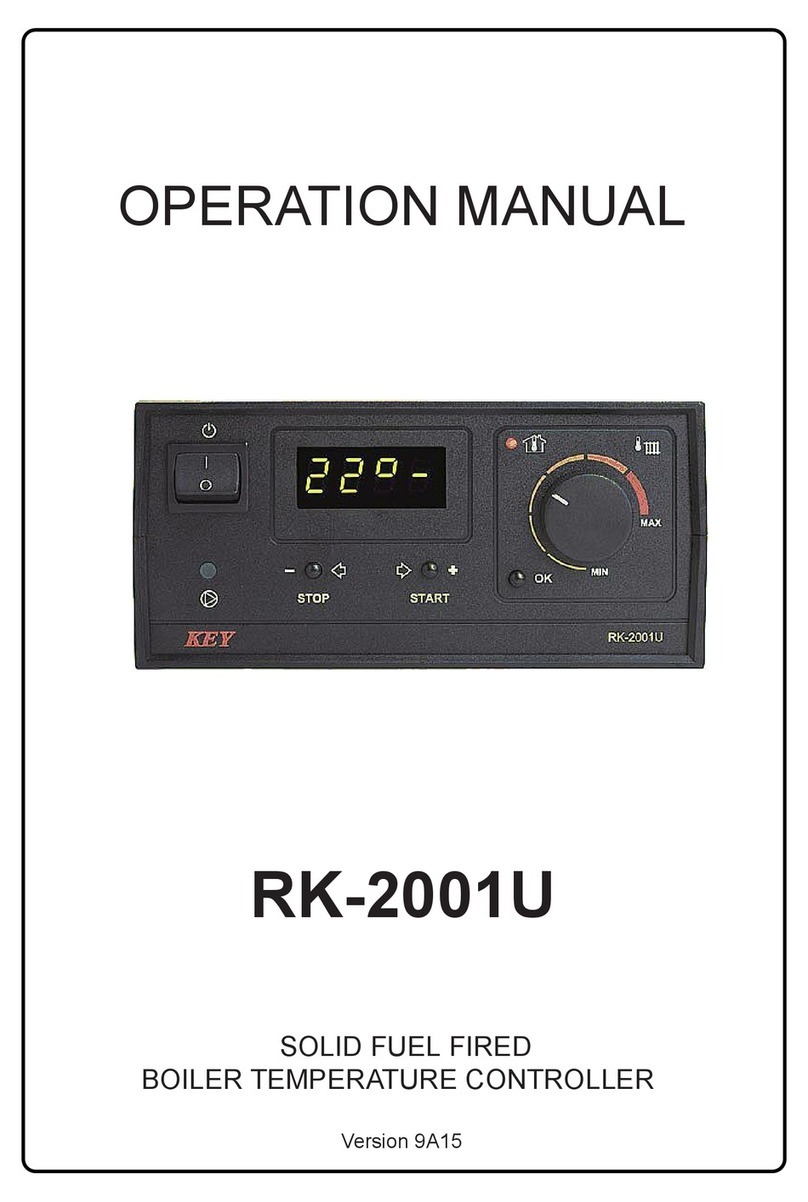
P.W. KEY
P.W. KEY RK-2001U Operation manual
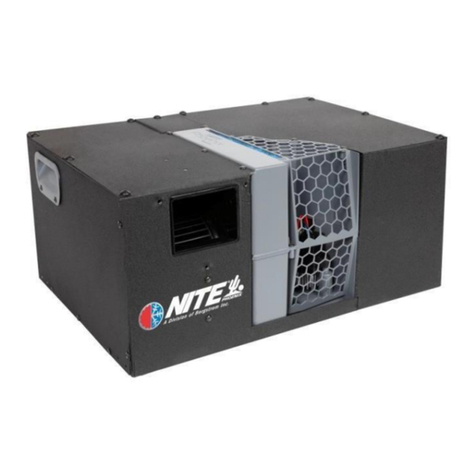
Bergstrom
Bergstrom NITE Kenworth T680 installation manual

ThermoFisher Scientific
ThermoFisher Scientific 2325 instruction manual
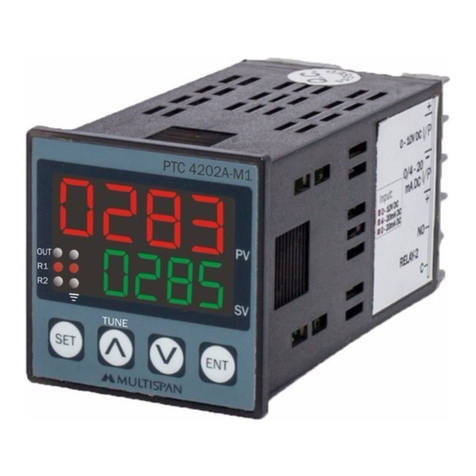
MULTISPAN
MULTISPAN PTC-4202A-M1 manual
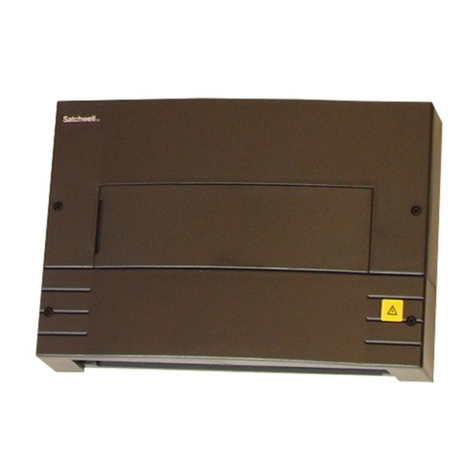
Satchwell
Satchwell MN650 Series installation instructions
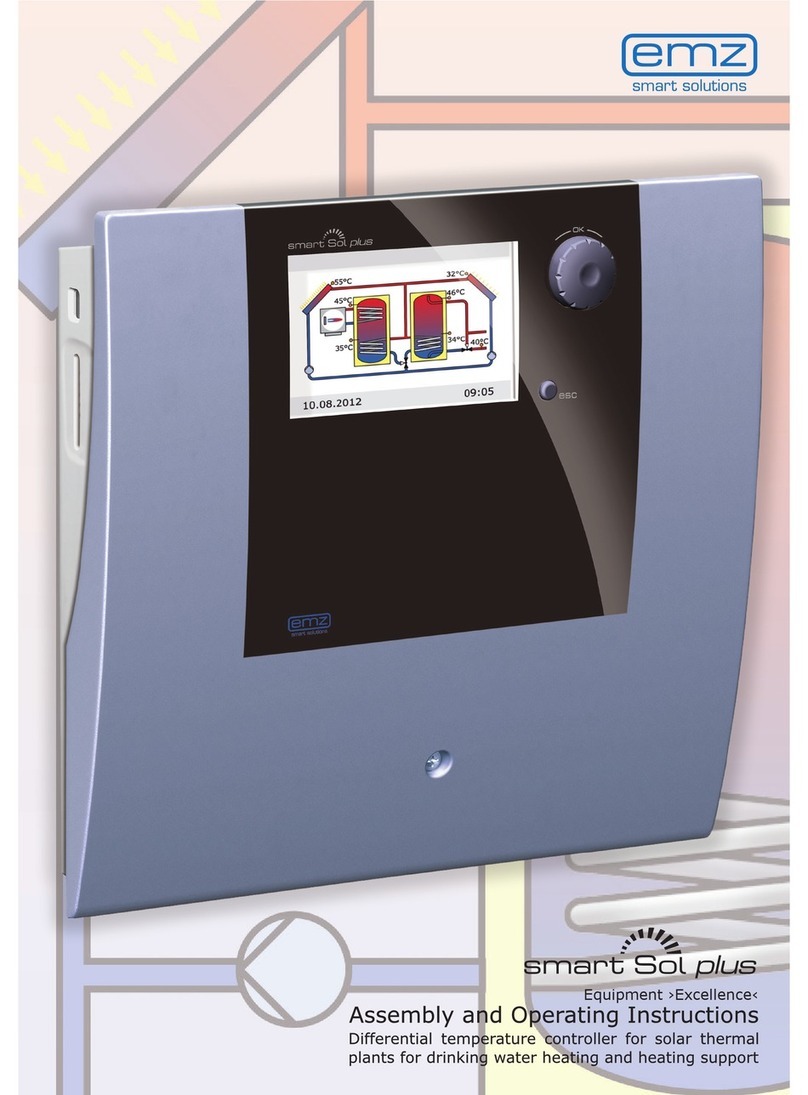
emz
emz smart Sol plus Assembly and operating instructions
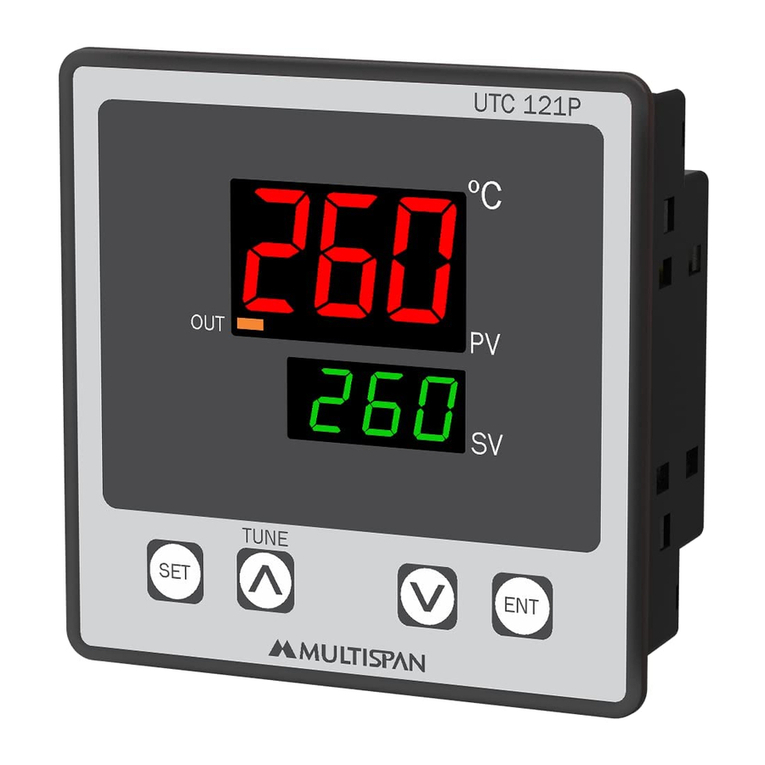
MULTISPAN
MULTISPAN UTC-121P user manual

Athena
Athena 6000 instruction manual
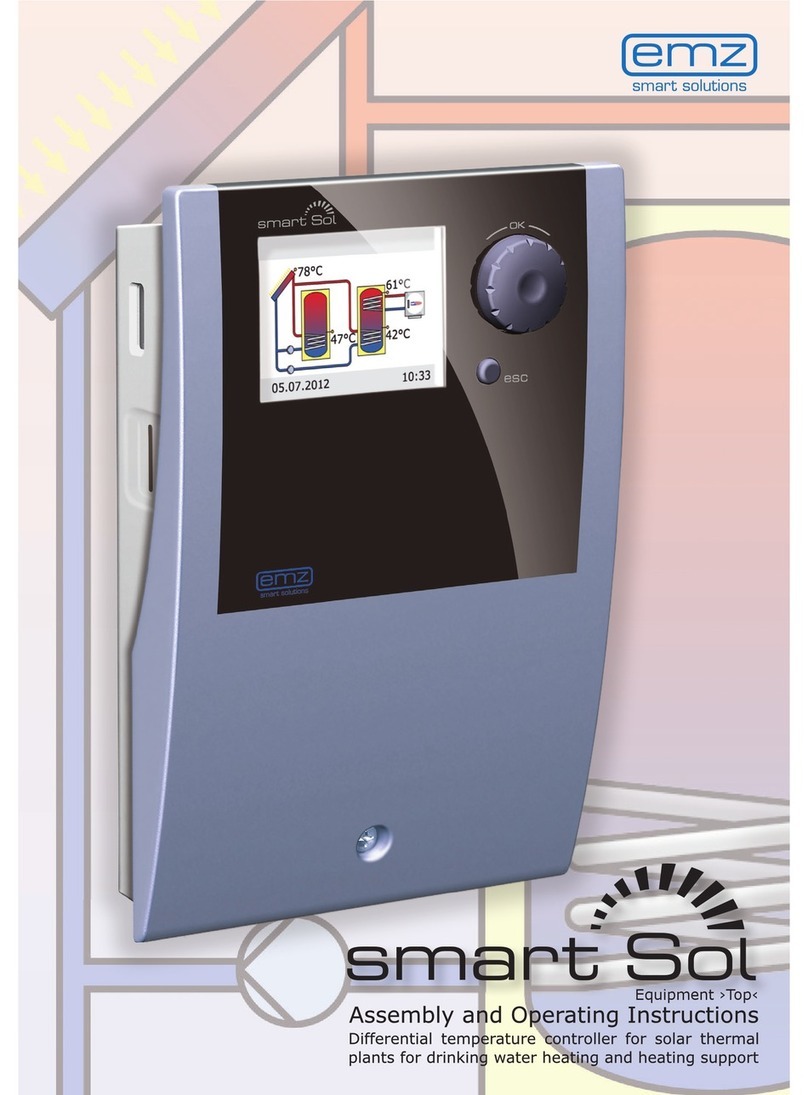
emz
emz smart Sol Assembly & operation
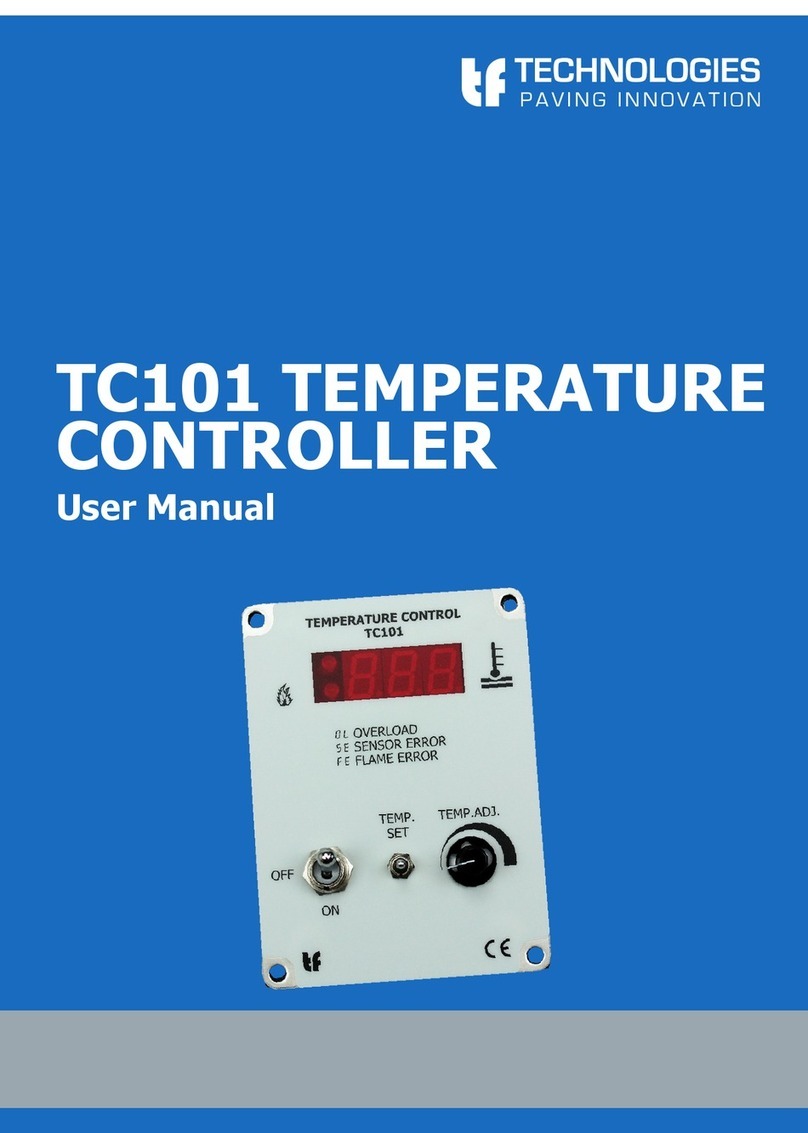
Technologies Paving Innovation
Technologies Paving Innovation TC101 user manual

Thermal Care
Thermal Care Vactherm RV Operation, installation, and maintenance manual

Honeywell
Honeywell MICRONIK 200 R7426A Installation & start-up instructions
